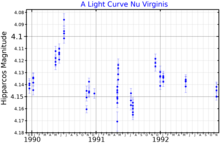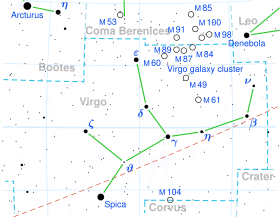Variable star in the constellation Virgo
ν Virginis , Latinized as Nu Virginis , is a single[ 9] star in the zodiac constellation of Virgo , located at the western tip of the classic constellation and nearly due south of the prominent star Denebola .[ 10] apparent visual magnitude of 4.04[ 2] naked eye . Because the star lies near the ecliptic it is subject to occultations by the Moon .[ 11] Parallax measurements provide an estimated distance of around 331 light years from the Sun ,[ 1] radial velocity of +50 km/s.[ 5]
A light curve for Nu Virginis, plotted from Hipparcos data[ 12] This object is an M-type red giant , currently on the asymptotic giant branch ,[ 3] stellar classification of M1 III.[ 4] variable star when the Hipparcos [ 13] [ 14] semiregular variable star with its brightness varying by 0.0125 in magnitude.[ 15] [ 16] mass of the sun , but it has expanded to 54 times the Sun's radius and shines 520 times as brightly as the Sun . The effective temperature of its outer atmosphere is 3,728 K.[ 7]
References
^ a b c d e Vallenari, A.; et al. (Gaia collaboration) (2023). "Gaia Data Release 3. Summary of the content and survey properties" . Astronomy and Astrophysics . 674 : A1. arXiv :2208.00211 Bibcode :2023A&A...674A...1G . doi :10.1051/0004-6361/202243940 S2CID 244398875 . Gaia DR3 record for this source at VizieR .^ a b c d Mermilliod, J.-C. (1986), "Compilation of Eggen's UBV data, transformed to UBV (unpublished)", Catalogue of Eggen's UBV Data , SIMBAD , Bibcode :1986EgUBV........0M . ^ a b Eggen, Olin J. (July 1992), "Asymptotic giant branch stars near the sun", Astronomical Journal , 104 (1): 275– 313, Bibcode :1992AJ....104..275E , doi :10.1086/116239 . ^ a b Morgan, W. W.; Keenan, P. C. (1973), "Spectral Classification", Annual Review of Astronomy and Astrophysics , 11 : 29– 50, Bibcode :1973ARA&A..11...29M , doi :10.1146/annurev.aa.11.090173.000333 . ^ a b c d Massarotti, Alessandro; et al. (January 2008), "Rotational and radial velocities for a sample of 761 HIPPARCOS giants and the role of binarity", The Astronomical Journal , 135 (1): 209– 231, Bibcode :2008AJ....135..209M , doi :10.1088/0004-6256/135/1/209 S2CID 121883397 . ^ Pace, G.; et al. (April 2003), "The Wilson-Bappu effect: A tool to determine stellar distances", Astronomy and Astrophysics , 401 (3): 997– 1007, arXiv :astro-ph/0301637 Bibcode :2003A&A...401..997P , doi :10.1051/0004-6361:20030163 , S2CID 17029463 . ^ a b Baines, Ellyn K.; Armstrong, J. Thomas; Schmitt, Henrique R.; Zavala, R. T.; Benson, James A.; Hutter, Donald J.; Tycner, Christopher; van Belle, Gerard T. (2017). "Fundamental parameters of 87 stars from the Navy Precision Optical Interferometer" . The Astronomical Journal . 155 (1): 16. arXiv :1712.08109 Bibcode :2018AJ....155...30B . doi :10.3847/1538-3881/aa9d8b S2CID 119427037 . ^ "* nu. Vir" . SIMBAD Centre de données astronomiques de Strasbourg . Retrieved 2016-09-08 .{{cite web }}: CS1 maint: postscript (link )^ Eggleton, P. P.; Tokovinin, A. A. (September 2008), "A catalogue of multiplicity among bright stellar systems", Monthly Notices of the Royal Astronomical Society 389 (2): 869– 879, arXiv :0806.2878 Bibcode :2008MNRAS.389..869E , doi :10.1111/j.1365-2966.2008.13596.x S2CID 14878976 . ^ Kaler, James B., "Nu Virginis" , STARS , retrieved 2019-10-06 . ^ White, Nathaniel M.; Feierman, Barry H. (September 1987), "A Catalog of Stellar Angular Diameters Measured by Lunar Occultation", Astronomical Journal , 94 : 751, Bibcode :1987AJ.....94..751W , doi :10.1086/114513 . ^ "/ftp/cats/more/HIP/cdroms/cats" . Centre de Données astronomiques de Strasbourg . Strasbourg astronomical Data Center. Retrieved 15 October 2022 .^ Kazarovets, E. V.; Samus, N. N.; Durlevich, O. V.; Frolov, M. S.; Antipin, S. V.; Kireeva, N. N.; Pastukhova, E. N. (January 1999). "The 74th Special Name-list of Variable Stars" (PDF) . Information Bulletin on Variable Stars . 4659 : 1– 27. Bibcode :1999IBVS.4659....1K . Retrieved 14 December 2024 . ^ Kazarovets, E. V.; et al. (1999), "The 74th Special Name-list of Variable Stars", Information Bulletin on Variable Stars , 4659 (4659): 1, Bibcode :1999IBVS.4659....1K . ^ Koen, Chris; Eyer, Laurent (March 2002). "New periodic variables from the Hipparcos epoch photometry" . Monthly Notices of the Royal Astronomical Society . 331 (1): 45– 59. arXiv :astro-ph/0112194 Bibcode :2002MNRAS.331...45K . doi :10.1046/j.1365-8711.2002.05150.x S2CID 10505995 . ^ Tabur, V.; et al. (December 2009), "Long-term photometry and periods for 261 nearby pulsating M giants", Monthly Notices of the Royal Astronomical Society , 400 (4): 1945– 1961, arXiv :0908.3228 Bibcode :2009MNRAS.400.1945T , doi :10.1111/j.1365-2966.2009.15588.x S2CID 15358380 .

